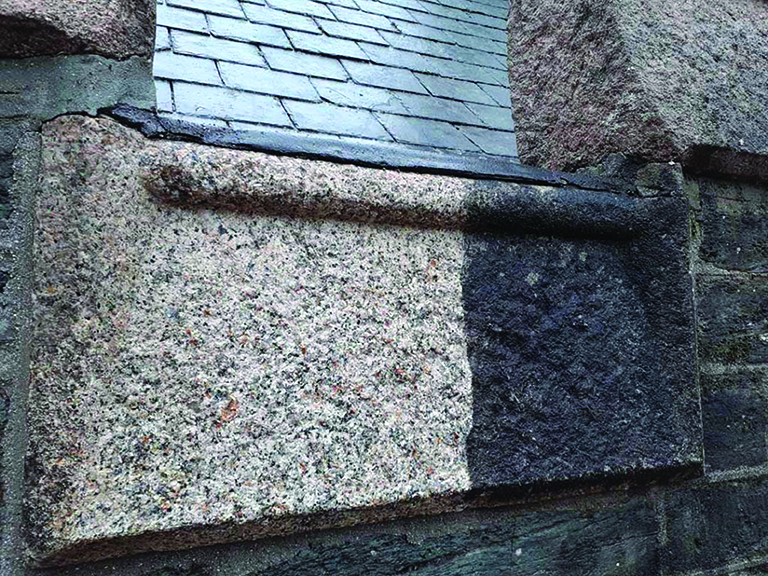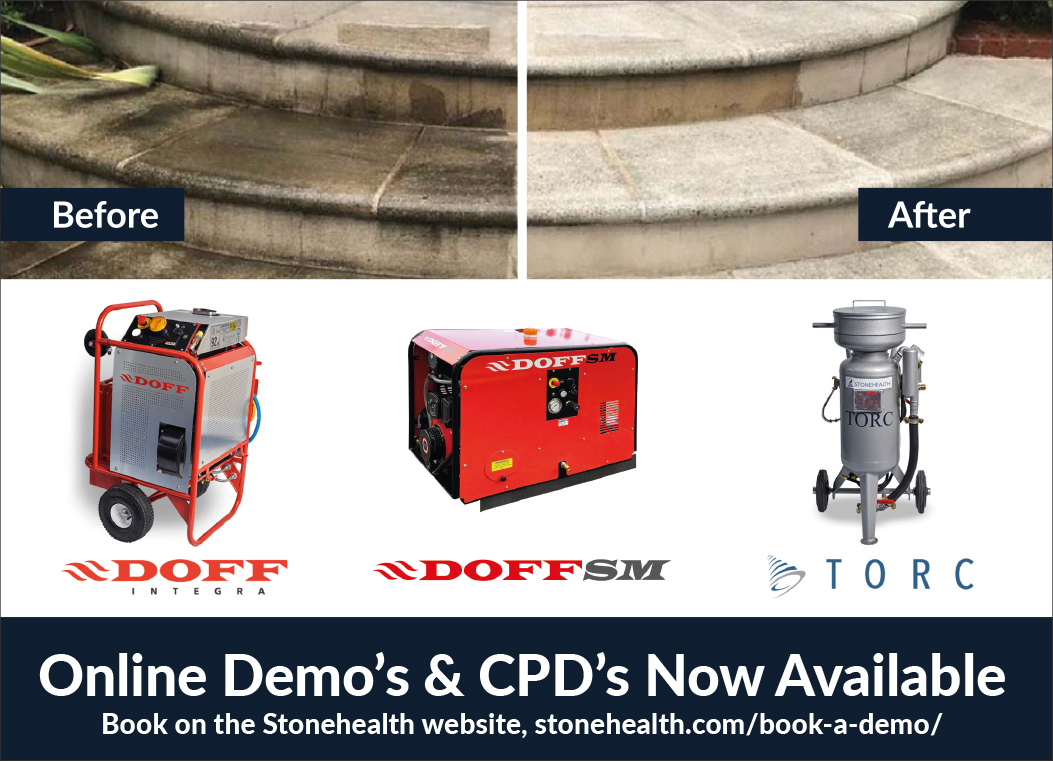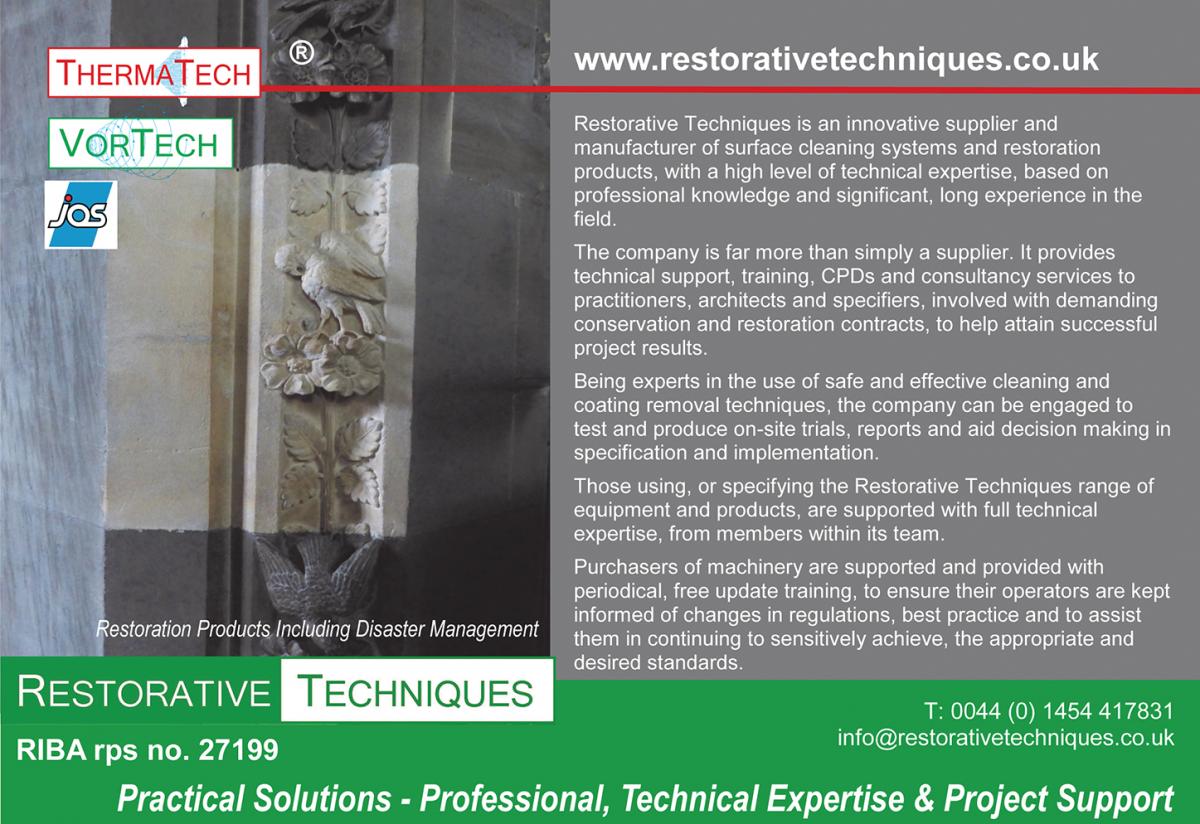The transformation achieved by cleaning a building or monument can be significant. Removing the accumulated dirt of perhaps centuries and exposing masonry as something akin to when it was installed can be like bringing it out of the shadows and into the sunlight.
For a long time, stone cleaning, especially of sandstone, was frowned upon and accused of accelerating decay. There were plenty of examples where stonework had been compromised by the inappropriate use of chemicals and high pressure blasting.
But the world has moved on and more recent research has challenged earlier evidence that cleaning leads to accelerated decay.
Stone cleaning does need to be carried out carefully by experienced operatives using appropriate methods and the level of cleaning needs to be determined and agreed before work starts in order for the desired results to be achieved. But the development of equipment and chemicals for cleaning stone has kept up with the changing attitudes towards carrying it out.
The results can certainly be transformative, as has been ably demonstrated this year in Tavistock, where Stonehealth’s Doff superheated water technology, which removes dirt and grime without causing harm or shock to the fabric of the building, has been used to transform the historic townscape in a project called the Guildhall Gateway, because it is a Gateway to the Cornwall & West Devon Mining World Heritage Site.
Tavistock was one of the Stannary towns where, from the 12th century on, tin was weighed, assayed and stamped. After a decline in tin mining, industrial scale mining followed in the 16th century and continued into the 20th century. For much of that time Cornwall led the world in the output of copper and arsenic.
The Dukes of Bedford in particular got even richer from this by claiming ownership of the land the mines were in and levying royalties. In the 19th century the seventh Duke remodelled Tavistock town centre, for which the town thanked him by putting up a statue of him in Guildhall Square carved by Exeter sculptor Edward Bowring Stephens. For the unveiling of it on 10 August 1864 locals were given a half-day holiday and 2,000 people turned out to enjoy a band, gun salutes, fireworks and what were described at the time as ‘bombs’. Part of the current scheme involved re-siting the statue in August this year next to a visitor information centre. It was hoisted on to its new plinth in front of about 30 socially distancing people who applauded as it was lowered into position.
Tavistock has some distinctive building stones, including the local green volcanic Hurdwick Stone, which can be described as granite, and the granite from Pew Tor. Both were used in the construction of the Guildhall, although much of the Hurdwick stone was recovered from the ruins of an abbey in the town that had been abandoned during the Dissolution of Monasteries.
The Guildhall and its associated buildings were constructed in 1848. Part of the Duke’s motivation for spending the £4,000 they cost was concern about public order as a result of the booming population of miners and others who moved to the area to cash in on its wealth. The Guildhall development included the UK’s first combined courtroom and police station. It also had a jail and a fire station.
The town council acquired the buildings in 2014. They were largely unoccupied and have remained so. The work on the current £1.8million project involves turning the historic Guildhall complex into a mining heritage centre and museum to explain the impact that mining had on the development of the town and what life was like as a miner in the 19th century.
The Guildhall is constructed mostly of the Hurdwick Stone with granite dressings and an embattled parapet above a moulded cornice. There are crocketted pinnacles to the parapets and the roofs are slate, Cornwall being a major slate producing county.
The buildings are listed Grade II*, reflecting their historic and aesthetic interest.
 The Doff system used to clean the stonework by Stonehealth approved contractor RM Builders & Contractors from Tavistock has proven highly effective at removing the accumulated biological matter, dirt and grime safely.
The Doff system used to clean the stonework by Stonehealth approved contractor RM Builders & Contractors from Tavistock has proven highly effective at removing the accumulated biological matter, dirt and grime safely.
Before the coronavirus lockdown in March, Guildhall Square had seen a great deal of activity in connection with the refurbishment work and the intention had been to open the new Guildhall Gateway this summer. The coronavirus has delayed that. Activity stopped as a result of the Covid-19 lockdown and did not resume until July.
Part of the scheme includes the redevelopment of the parking area in Guildhall Square with the re-use of many of the existing materials, including the cobbles. The scheme is being led by Tavistock Town Council, in partnership with Tavistock Heritage Trust, and has received support from the National Lottery Heritage Fund as well as organisations throughout the town and the region.
In spite of projects like Tavistock, Stonehealth Managing Director James Diamond says: “Do I think 2020 is going to be our best year to date? No.”
The company, which also makes the Torc gentle abrasive cleaner and supplies a whole range of other products and chemicals for cleaning masonry, was shut down for a couple of months with much of the team furloughed.
However, they have learnt new skills of digital communication, especially video conferencing, that they will continue to use going forward.
With live meetings difficult, a lot more contact with clients and customers has been online and Stonehealth has invested in new camera equipment to offer more online demonstrations and training, some of which can be accessed through a new Stonehealth education portal on its website and some of which is live.
If anyone anywhere in the world wants a live demonstration or the RIBA-approved CPD the company offers they can often have it at short notice, even the same day, by Zoom or WhatsApp.
Stonehealth is also about to launch a new version of its online Contractors Directory, which will now be available worldwide so specifiers from any of the territories its contractors operate in will have easy access to local Rosette-approved companies.
There was a major product development Stonehealth intended to launch this year but has decided to leave until the spring. It has been in development for almost three years and when launched will, the company promises, bring some long awaited technical advances to the stone cleaning sector.
Stonehealth has, however, launched the Doff SM (Skid Mount), predominantly aimed at contractors looking for a van or trailer mounted version of the Doff, although it is also useful for using in the operator’s own workshop. It is a diesel powered, compact, self-contained unit that only requires a water supply to operate. This gives additional versatility while still offering the same reliable and efficient performance as the Doff Integra.
Another major supplier of superheated water cleaners, gentle abrasive systems and a range of other products and chemicals used for stone cleaning is Restorative Techniques.
It says it has had a lot of interest in its ThermaTech and ThermaTech Inox superheated water cleaning systems from overseas lately, with units having gone to the USA, New Zealand, Australia, South Africa, Canada, Ireland, Switzerland and, now, to France for cleaning the Eiffel Tower.
Because of its ability to clean without damaging the substrate it is used by the Commonwealth War Graves Commission at its cemeteries and memorials around the world.
And it is also now being increasingly used to clean Roman archaeological sites. It started with a project in Switzerland, where archaeologists were cleaning an underground Roman site that had a problem with mould.
Because archaeology is a fairly small and communicative community and the archaeologists were clearly impressed with the ThermaTech, it has since been specified for other projects involving Roman excavations in various countries.
“We’re incredibly busy at the moment,” says Director Julia Fairchild. “New machines are flying out the door. At times this year we have had trouble keeping up with demand for sales of the machinery.”
One of the company’s customers has even found a new use for the ThermaTech during the Coronavirus pandemic – cleaning smoking areas outside hospitals. The high temperature kills the virus and the ThermaTech also makes the enclosure look clean, which gives people confidence to use it.
ThermaTech has a modular design that allows the additions of attachments such as a vacuum extraction unit and a unit to add an abrasive to the superheated water where more aggressive cleaning is required.
“The abrasive attachment has really taken off,” says Julia. One of its advantages is that it does not require a compressor to deliver it as the venturi effect of the nozzle delivering the superheated water draws in the abrasive. The amount of abrasive being added is easily controlled.
The ThermaTech Inox adds features such as the option of a diesel-driven pump instead of the standard electric pump, a stainless steel boiler and a higher heat output of up to 12 litres per minute flow, particularly useful when two people are using the same machine at the same time on a project or high temperature-demanding jobs such as paint stripping are being carried out. The increased performance means that a 65 degree spray nozzle can be used for an even faster rate of work.
Among the overseas projects the ThermaTech Inox has been used for this year is cleaning the marble dome of the Jefferson Memorial in Washington DC in the USA as part of an $8.2million renovation programme.
The work is being carried out by a company called EverGreene Architectural Arts using, among other equipment, four of Restorative Techniques’ ThermaTech Inox units.
They were special builds, with not only stainless steel boilers but also stainless steel coils, even though Restorative Techniques says stainless steel coils are not strictly necessary as there are no corrosion issues with the standard coils.
Three of the units were ordered just after the UK went into the coronavirus lockdown, so there were just the three Directors of Restorative Technique (Julia, her husband Jamie Fairchild and their son, also Jamie) to build and dispatch the machines while the firm was otherwise closed for a month-and-a-half.
The Jefferson Memorial is a marble temple. It is a significant monument to one of the American ‘Founding Fathers’, designed by John Russel Pope and completed in 1943.
EverGreene was engaged by the National Park Service to clean the marble of the dome and pediment roof as part of the major restoration of the structure.
Work began last year and should be coming to a finish about now. It involves cleaning off biological growth as well as deposited dirt. The ThermaTech is ideal for that because the high temperatures also kill off spores that could lead to re-colonisation. The removal of spores means a cleaned surface remains clean for an extended period.
As for product developments, Julia says: “We’re always introducing new things, sometimes relating to machinery/equipment and at other times new chemical and poulticing products to our range.” There are videos of the products on Vimeo and Restorative Techniques says it is currently working on producing an interactive brochure for chemicals to join those already available for machines.
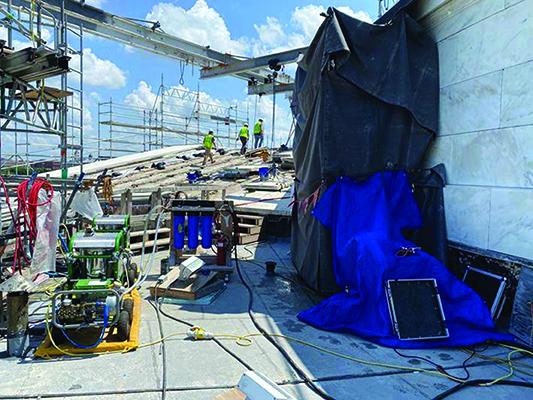
Two of the specially built ThermaTech Inox units on the Jefferson Memorial. Photo: Victoria Sanchez www.victoriasanchez.com
A light clean for stonework
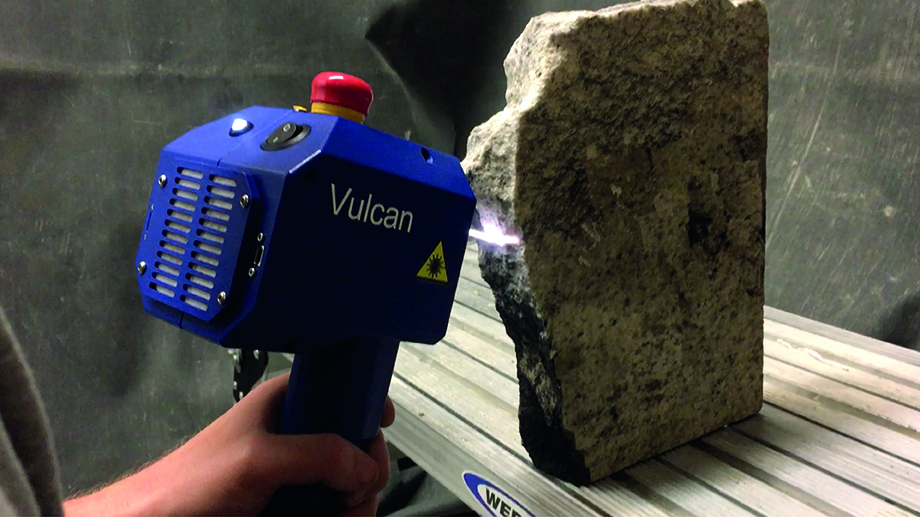
Lasers are a relative newcomer to the mix of stonecleaning products, which more commonly involve a variety of abrasives, chemicals and, of course, water.
The concept of the laser and the making of the first one goes back to the 1960s. But nobody had any idea what it could be used for at that time. Over the years, uses were found for the technology and in the 1990s lasers started to be used for cleaning stone, but it was slow and expensive so its use tended to be restricted to the delicate cleaning of museum pieces.
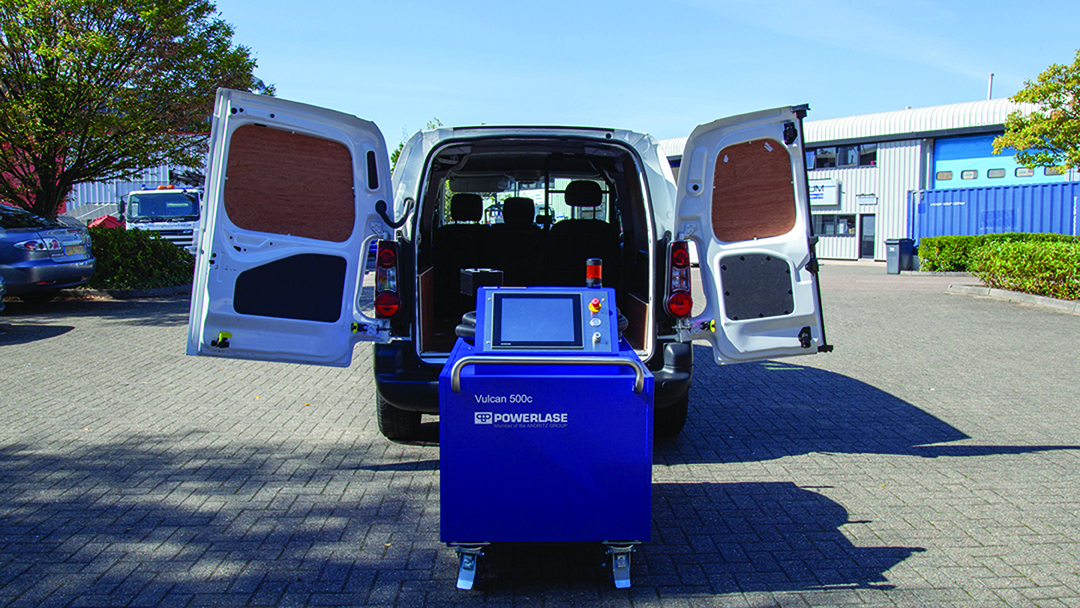
The equipment still has a high initial outlay to buy, but mobile, self-contained lasers have made the use of the technology in the field more practical.
Four lasers made by Powerlase in Crawley, West Sussex, were used by the American contractor EverGreene Architectural Arts as part of the cleaning regime for first the White House and now the Jefferson Memorial in Washington DC.
When they were used for the White House the company that supplied them was called Andritz Powerlase, because it was owned by Andritz.
Andritz has various businesses and the lasers came under the metals division because they are mostly used in the automotive trade for cleaning engines and other metalwork.
Andritz Powerlase went into Administration last year but its intellectual property was bought by Tyrone Crook in Australia, who runs the company with his business partner Mike Games in South Africa, whose skill set includes lasers.
One of the attractions was the company’s patented laser beam source, which is particularly stable and controllable.
The Vulcan 500W system used by EverGreene is designed to fit in the back of a van. It is light enough to lift in and out, is easy to use and has wheels so it can be moved around a site. In the UK it works with 240V or 110V power supply. Just plug it in.
The compact hand tool allows you to get into nooks and crannies. It has state of the art universal controls and simple synchronization, so it works quickly. It is safer than most abrasive or superheated water systems if it comes into contact with people, although you would not want it in your eyes. Safety measures on site should include protective goggles for the users and screens around the areas being cleaned to prevent the laser accidentally being pointed at fellow workers and to stop anyone without eye protection from entering the zone. But run the beam over your hand and it will remove the dirt without doing you any harm – although the company advises against pointing it at people.
When you consider a laser can cut through most materials, including metals, you might wonder how you can put your hand in front of it without losing it. The explanation is that the lasers used for cleaning pulse the light rather than producing a constant beam.
If you want an idea of how it works on stone check out a video posted by Andritz Powerlase at bit.ly/YouTubeLaser.
Mike Games says the four Vulcan 500W lasers bought by EverGreene cost £230,000 each and probably helped EverGreene get the first government contract at the White House that led on to the second at the Jefferson Memorial. Get the right project and the lasers can pay for themselves in six months, says Mike.
Powerlase also offers a 200W laser at £87,000 and has now partnered with a company in China that produces even lower powered lasers selling at £14,500. But the lower the power the slower the clean.
In the UK, Mike says construction is on his hit list of industries to target, although not necessarily selling the kit. Powerlase could provide laser cleaning as a service for sensitive areas of a project, perhaps supplying two or three lasers with operators at around £700 for an eight hour day.
Mike says lasers might take slightly longer to clean stonework than abrasives, but you can address the residue build up without damaging the substrate in any way. “That’s where a laser is cutting edge,” he says.
And when using abrasives or water, there is also the question of disposing of the cleaning medium and the dirt removed. With lasers there is no medium to dispose of and the dirt is mostly vaporised.
Lasers produce a uniform clean, which can include a conservation clean, although like any cleaning system that relies on the skill of the operator. Mike says operators used to grit blasting and spray painting tend to adapt most readily to using lasers.
A current use of Powerlase technology is cleaning the bones found at the Cradle of Human Kind in South Africa. Previously chemicals were used, which had only a 60% success rate and took months. Lasers do the work quickly and efficiently.
A gentle French scrub-up for Somerset House
Two years ago the London-based façade cleaning and restoration company Thomann-Hanry worked on the courtyard façades of Somerset House. Mick Figg, Head of Buildings at Somerset House, says the results were “tremendous”, so the company has now been engaged in a further programme of works. Last year it began cleaning and renovating the famous riverside façade on the south wing and it is scheduled to return to complete the remaining façades.
The advantages of the Thomann-Hanry ‘façade gommage’ process of cleaning are that it does not require scaffolding, because the cleaning takes place in a self-contained, lightweight negative air pressure cabin (so it does not cover the area in the cleaning medium used) that can be suspended from outriggers or mounted on a hydraulic boom truck.
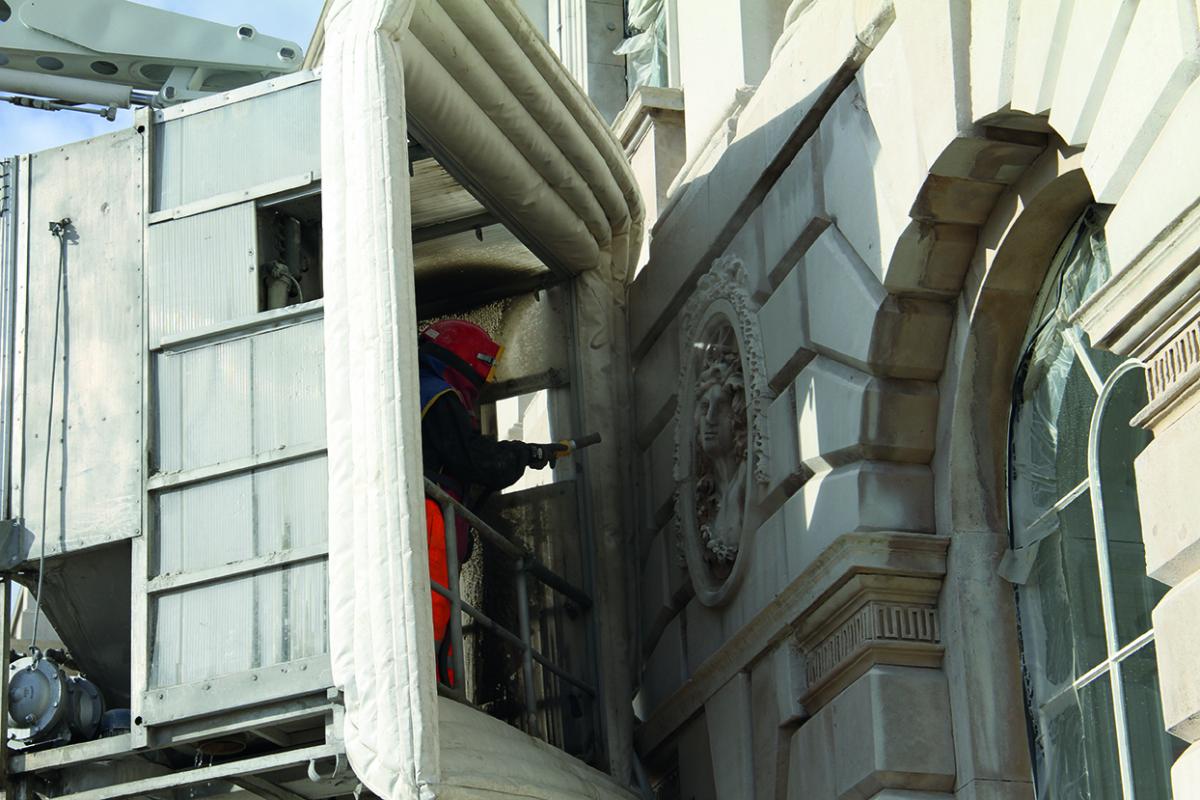
Thomann-Hanry’s Façade Gommage cleaning cabin at Somerset House.
The operator projects ultrafine dry particles across the surfaces to be cleaned, which gently rubs away the dirt before the residue is filtered back through a water curtain for recycling. The cleaning particles used are aluminium silicate, a chemically inert by-product of aluminium smelting, adding to the green credentials of the process.
At Somerset House Thomann-Hanry cleaned the entire elevation of the south Wing over some 12 weeks from late autumn into the early new year, carried out from mobile hydraulic platforms. It had to be done over winter because the building is a highly sought-after venue for summer event hire and would normally be fully booked. As it turned out, the winter included three massive storms, making the advantages of façade gommage being a non-scaffold system even more apparent than usual. Mick Figg: “Not having to use scaffold on the building really influenced our decision to go with Thomann-Hanry. It makes the works really flexible compared with having a big scaffold.”
All the machinery had to be lifted to terrace level for the project, which presented some interesting logistical challenges, although Thomann-Hanry have extensive experience of working on sites that are difficult to access.
Once the cleaning was complete, the company’s team of painters, decorators, stoneworkers and banker masons carried out repair and replacement work on the masonry of the windows, façades and balusters.
This landmark building is just to the east of Waterloo Bridge, built on the site of a Tudor palace belonging to the Duke of Somerset. It was designed by Sir William Chambers in 1776, with construction completed in 1780. Chambers’ Palladian architecture has given it a giant order of pilasters and engaged columns that span the piano nobile and mezzanine.
It is elegantly arranged around a large interior court. Further outer wings were added by the Victorians in 1831 and 1856. Until the Victoria Embankment was constructed in the late 1860s the River Thames lapped up to the south wing, and three great arches enabled boats and barges to land at the building.
Somerset House was designed as one of the first London buildings to house government and educational institutions – such as the Royal Academy and the Society of Antiquaries. Its name is synonymous with the registry of births, marriages and deaths, although these days it is a creative hub, home to some of London’s most celebrated names in the arts, including the National Youth Orchestra, the British Fashion Council, and the Courtauld Gallery and Institute.
The past two years have also seen Thomann-Hanry’s expertise on façade cleaning and stonework restoration used on King’s College in Cambridge, The National Gallery and The Reform Club in London, hotels including Sofitel St James’s and some of the most prestigious theatres in the West End.
If you would like to watch a video of the work at Somerset House with comments from Mick Figg, go to bit.ly/2SYda2F.
LTP introduces Black Spot & Algae Remover
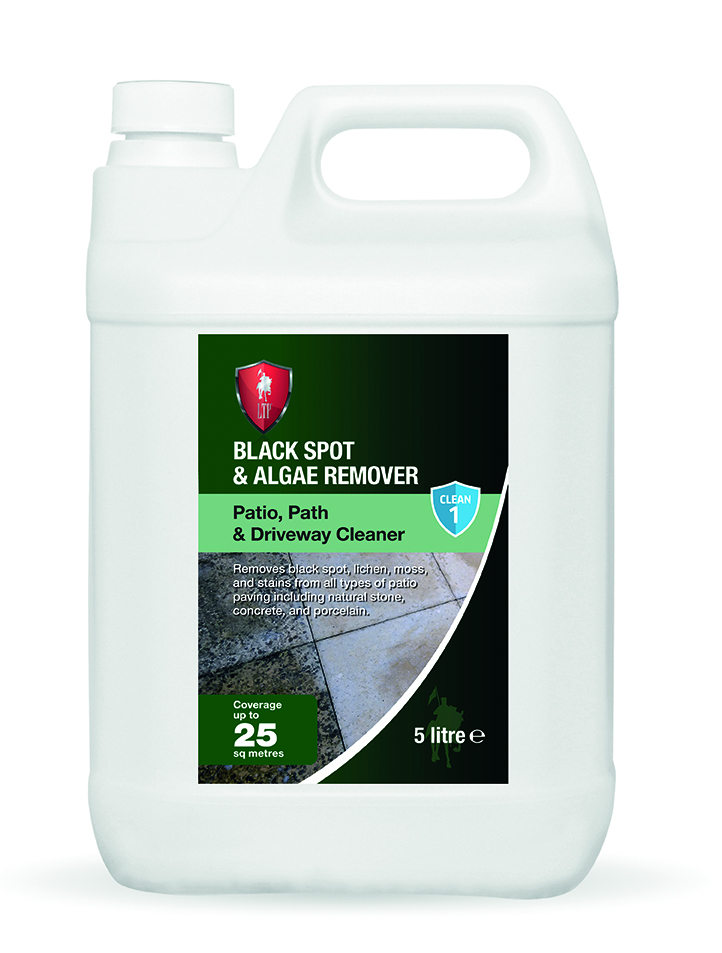 Manufacturers have been reluctant to launch new products this year, but in January, before the coronavirus pandemic had started impacting the UK, LTP introduced a new Black Spot & Algae Remover.
Manufacturers have been reluctant to launch new products this year, but in January, before the coronavirus pandemic had started impacting the UK, LTP introduced a new Black Spot & Algae Remover.
It restores the appearance of natural stone, concrete, brick and porcelain, giving results in as little as two hours. It is ideal for paths, patios and driveways.
Made in the UK, Black Spot & Algae Remover targets organic residues, including black spot, lichen, moss and algae. It removes the stains caused by damp and slippery leaf matter. Before application, surfaces should be swept clean. The treatment is applied neat, using a watering can or light pressure garden spray, and left to act for 2-4 hours, during which time it will fizz, breaking down residues. Its bleaching action removes stains. To finish, hose off with clean water. The remover can be used on dry and slightly damp surfaces.
Once cleaned, the surfaces can be protected with LTP External Stone Sealer or LTP Porcelain Protector. Both create a barrier without altering the surface appearance to inhibit the re-appearance of algae, mould and black spot and the staining they cause.

